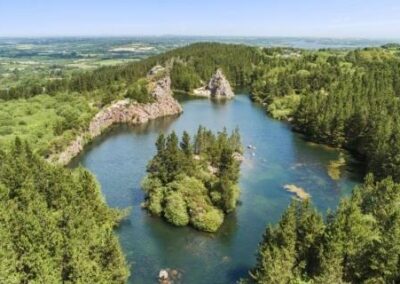Coillte is encouraging the people of Wexford to enjoy their local forest over the winter months as 86% of survey respondents say forests are important for physical and mental health and wellbeing.
Wexford’s top Coillte Forests for recreation include Tintern Abbey Forest, Browncastle Wood and Forth Mountain.
A total of 81% of the Irish public believe Ireland needs to grow more trees to help combat climate change, according to a recent Red C Research survey commissioned by Coillte, the semi-state forestry company.
Furthermore, 86% of those surveyed agree that getting out into nature and exploring their local forest has a positive impact on their physical and mental wellbeing, while 82% believe forests are important for nature and biodiversity, which is central to Coillte’s strategic vision.
Of all respondents, 74% agree that having a mix of trees, such as conifers that grow quickly and capture carbon at a high rate, along with broadleaves that provide a long-term store of carbon, is important for climate action. In terms of tackling climate change, the majority surveyed (66%) are in favour of using Irish wood as an alternative building material to high-carbon materials such as concrete and steel.
Speaking about the survey, Ken Sweeney, Regional Manager Coillte, said, “The connection between forests and our overall wellbeing is recognised by the majority of the Irish public, as revealed in our survey. As we approach the busy festive season, we are encouraging people to explore their local forest and reconnect with nature. Wexford has some great Coillte forests for people to enjoy including Tintern Abbey Forest, Browncastle Wood and Forth Mountain.”
The survey findings support Coillte’s forestry strategic vision which aims to deliver multiple benefits from its forests and bring more focus to climate action, with ambitious targets on biodiversity and recreation, while continuing to deliver for the forest and wood products industry. The focus of Coillte’s vision is on sustainably balancing and delivering the multiple benefits from Ireland’s state forests across four strategic pillars: Climate, Wood, Nature, and People.
Coillte’s forestry strategic vision, announced last year, is designed to optimise its contribution to Ireland’s climate targets, and includes a range of actions aiming to capture approx. 28m tonnes of CO2 from the environment by 2050. Actions include:
- Coillte aims to enable the creation of 100,000 hectares of new forests by 2050, half of which will be native woodlands, thereby enabling the sinking of 18m tonnes of CO2 by 2050.
- Coillte will manage its existing forest estate to capture an additional 10m tonnes of CO2 by 2050;
- Coillte plans to produce 25 million m3 of certified Irish timber, to support the construction of 300,000 new homes in Ireland by 2030. It will also promote the use and benefits of wood products to increase the level of timber homes from 20% to 80% by 2050;
- Coillte intends to enhance and restore biodiversity by increasing the area of the forest estate being managed primarily for nature from 20% to 30% by 2025 and to 50% in the long term,
- Coillte plans to enable the investment of €100 million to create world class visitor destinations to support growth in tourism and recreation by 2030. In addition, it will double the number of recreation areas nationally to 500, to benefit local communities and peoples’ wellbeing.
- New strategic vision will be underpinned by Coillte’s commercially successful business and aims to enable the creation of 1,200 direct and indirect jobs in rural communities to support the just transition to a low carbon economy in Ireland.
Coillte is responsible for the management of 440,000 hectares of Ireland’s forests, which represents 7% of the country. Since its establishment in 1989, it has enabled the development of a vibrant forestry and wood products sector that supports rural employment throughout Ireland. While sustainability has always been central to the way in which Coillte manages the forest estate, Coillte believes that the growing climate and biodiversity crises, as well as societal demands for housing, jobs and wellbeing, are driving a need for greater change.
More information about local Coillte Wexford Forests
Tintern Abbey Forest is situated at an inlet beside a small stream, bursting with drifts of ferns, bluebells and wild garlic in the spring months. Among other fascinating natural features found in the forest here are mature beech trees, up to 200 years old. There is also a beautiful restored walled garden situated in the woods. Tintern contains five waymarked trails for its visitors: The Abbot John Torrell Cistercian Trail, The Buggy Trail, the Caesar Colclough Trail, Marie Biddulph Colclough Trail and the Mr. Rose’s Garden Trail. This forest also featues a new car park and new toilet facilities.
Browncastle Wood contains stunning natural sites such as St. Munna’s Bed and St. Munna’s well. St. Munna’s Bed is a large flat rock that protrudes from the side of the valley and is believed to a retreat where St. Munna would rest during the monastery’s founding. A cross is hewn across its centre, and it is believed by some that the rock has remedial properties, aiding back aches and pains. The return section of the walking looped trail follows alongside a river, where trout can be seen on occasion. Steps to St. Munna’s Well are located at the end of the path.
Forth Mountain is a stunning woodland area, featuring several carparks and lay-bys along with networks of forest roads and paths and two waymarked walking routes. On clear days, visitors can enjoy delightful views of nearby counties including Carlow, Kilkenny, Tipperary, Wicklow and Waterford. The flora amongst the trees here include heather, heath and furze; these are especially beautiful in Autumn when they turn to purple and gold colours, which incidentally are the Wexford county colours.
Coillte has an open forest policy and welcomes all visitors to its forests according to the principles of Leave No Trace.

